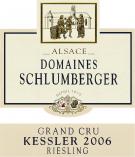History
Distinguished right from 1394, KESSLER has been sold under its own name since 1830.
Location
The Kessler grows on a sandstone soil and displays in its centre a valley that is globally facing east, south-east, which protects it from north winds and cold air streams brought by the valley of Guebwiller. As a natural extension of the Grand Cru Kitterlé, its subsoils are reddish over Vosgean sandstone bedrock. At its base, an outcrop of limestone results in clay soils.
Wine-making
The grapes are hand-picked and whole bunches are pressed. There is static settling of the lees. The wine is fermented in temperature controlled tuns, followed by raising on the less for 8 months.
Gastronomy
- Roasted scallops salad with orange
- Lobster ravioli
- Seafood, shellfish, fish terrine
- Fish cooked, raw or in sauce
- Ideal with choucroute
- Quiches, pies, salads
- Roasted poultry or in sauce
- Cheeses
Serve at 12°C
Learn more about food & wine pairing
Tasting
The robe is a light golden yellow with green reflections of good intensity. The disk is bright, limpid and transparent. The wine has a vivid youthful quality.
The nose is marked, pleasant, with a good intensity. It gives out a complex dominant of fruity scents, citrus fruits, lemon peel. Airing remains reserved but a slightly candied hint can be perceived. The grapes display a smoothness and a level of maturity that will allow it to reveal itself later.
The onset in the mouth is ample and fleshy. The alcoholic base is full-bodied. One evolves on an edgy and precise medium where the range of flavours reveals the fruitiness of citrus fruits as well as a very delicate floral character and an underlying minerality, together with a hint of bitterness.
The finish offers a moderate length, 6 caudalies, and a sharp vivacity.
Time will allow this wine to open out.
Technical sheet elaborated by M. Pascal Leonetti
Best Sommelier of France 2006
Sommelier at l’Auberge de l’Ill (*** Michelin)
















